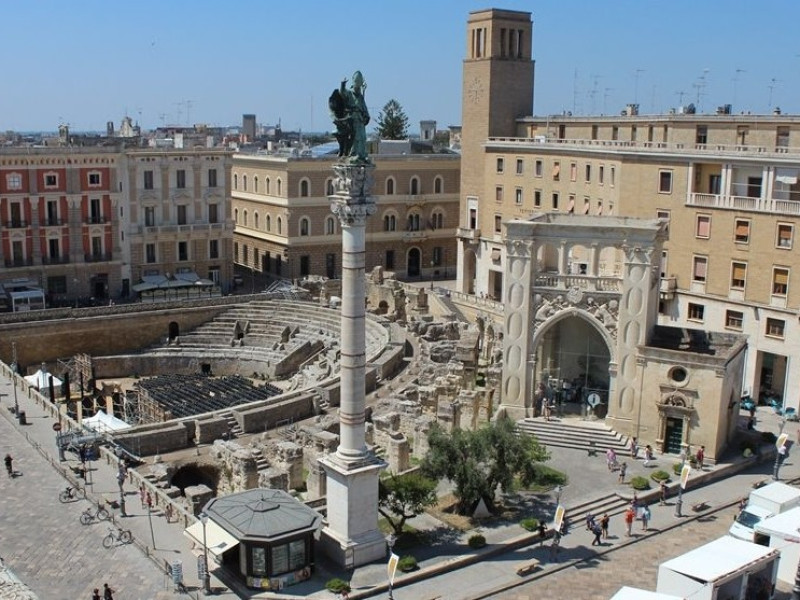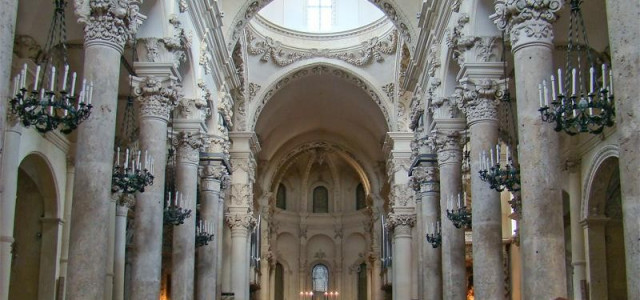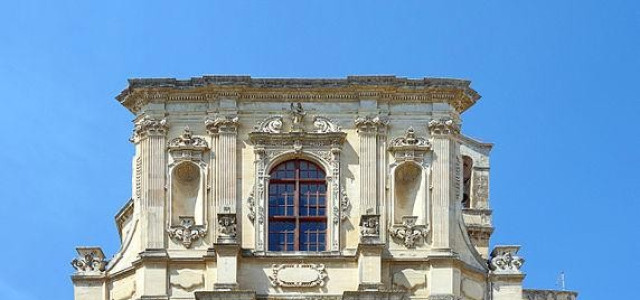Lecce
Lecce (Italian: [ˈlettʃe] ( ), Griko: Luppìu, Latin: Lupiae, Ancient Greek: Ἀλήσιον) is a historic city of 95,200 inhabitants in southern Italy, the capital of the province of Lecce, the second province in the region by population, as well as one of the most important cities of Apulia. It is the main city of the Salentine Peninsula, a sub-peninsula at the heel of the Italian Peninsula and is over 2,000 years old. Because of the rich Baroque architectural monuments found in the city, Lecce is commonly nicknamed "The Florence of the South". The city also has a long traditional affinity with Greek culture going back to its foundation; the Messapii who founded the city are said to have been Cretans in Greek records. To this day, in the Grecìa Salentina, a group of towns not far from Lecce, the griko language is still spoken. In terms of industry the "Lecce stone" is the city's main export, because it is very soft and malleable, thus suitable for sculptures. Lecce stone is a kind of limestone. Lecce is also an important agricultural centre, chiefly for its olive oil and wine production, as well as an industrial centre specialising in ceramic production. History According to legend, a city called Sybar existed at the time of the Trojan War, founded by the Messapii. It was conquered by the Romans in the 3rd century BC, receiving the new name of Lupiae. Under the emperor Hadrian (2nd century AD) the city was moved 3 kilometres (2 miles) to the northeast, taking the name of Licea or Litium. Lecce had a theater and an amphitheater and was connected to the Hadrian Port (the current San Cataldo). Orontius of Lecce, locally called Sant'Oronzo, is considered to have served as the city's first Christian bishop and is Lecce's patron saint. After the fall of the Western Roman Empire, Lecce was sacked by the Ostrogoth king Totila in the Gothic Wars. It was conquered by the Byzantines in 549, and remained part of the Eastern Empire for five centuries, with brief conquests by Saracens, Lombards, Hungarians and Slavs. After the Norman conquest in the 11th century, Lecce regained commercial importance, flourishing in the subsequent Hohenstaufen and Angevine rule. The County of Lecce was one of the largest and most importants fiefs in the Kingdom of Sicily from 1053 to 1463, when it was annexed directly to the crown. From the 15th century, Lecce was one of the most important cities of southern Italy, and, starting in 1630, it was enriched with precious Baroque monuments. To avert invasion by the Ottomans, a new line of walls and a castle were built by Charles V, (who was also Holy Roman Emperor), in the first part of the 16th century. In 1656, a plague broke out in the city, killing a thousand inhabitants. In 1943, fighter aircraft based in Lecce helped support isolated Italian garrisons in the Aegean Sea, fighting Germans during World War 2. Because they were delayed by the Allies, they couldn't prevent a defeat. In 1944 and 1945, B-24 long-range bombers of the 98th Heavy Bomb Group attached to the 15th U.S. Army Air Force were based in Lecce, from where the crews flew missions over Italy, the Balkans, Austria, Germany and France. Main sights Churches and religious buildings The most important is the Church of the Holy Cross (Chiesa di Santa Croce). It was begun in 1353, but work was halted until 1549, to be completed only in 1695. The church has a richly decorated façade with animals, grotesque figures and vegetables, and a large rose window. Next to the church is the Government Palace, a former convent. Lecce Cathedral is also one of the most significant cathedrals in Italy. It was originally built in 1144, and rebuilt in 1230. It was totally restored in the years 1659–70 by Giuseppe Zimbalo, who also built the 70-metre (230 ft) high bell tower, which has five storeys and an octagonal loggia. The church of San Niccolò and Cataldo is an example of Italo-Norman architecture. It was founded by Tancred of Sicily in 1180. In 1716 the façade was rebuilt, with the addition of numerous statues, but maintaining the fine original portal. The interior has a nave and two aisles, with ogival arcades and a dome in the centre of the nave. The frescoes on the walls are from the 15th-17th centuries. The Celestines' Convent (1549–1695), with Baroque decorations by Giuseppe Zimbalo. The courtyard was designed by Gabriele Riccardi. The church of the Theatines (dedicated to Saint Irene, built from 1591 by Francesco Grimaldi). It has a large façade showing different styles in the upper and lower parts. The portal is surmounted by a statue of Saint Irene by Mauro Manieri (1717). The interior is on the Latin cross plan and is rather sober. It has an altar of Saint Michael the Archangel with a copy of the eponymous painting by Guido Reni. The high altar has a Transport of the Holy Ark by Oronzo Tiso. In the right transept is one of the largest altars in Lecce, dedicated to Saint Cajetan (1651). Nearby is the Rococo altar of Saint Andrew Avellino. Also from the mid-17th century is the altar of Saint Orontius by Francesco Antonio Zimbalo, followed by the altar of Saint Irene with a canvas by Giuseppe Verrio (1639), nine busts of saints housing relics and a large statue of the saint. The altar of Saint Stephen has the Stoning of St. Stephen by Verrio. Church of San Matteo, built in 1667. It has a typical central Italy Baroque style. It has two columns on the façade, only one of which is decorated, though only partially. According to a local legend, the jealous devil killed the sculptor before he could finish the work. Church of Santa Maria degli Angeli Church of Santa Chiara (1429–1438), rebuilt in 1687 Church of San Francesco della Scarpa, known as the "church without façade" as the latter has been demolished in the 19th century restorations. The most ancient section dates likely to the 13th-14th centuries; the interior is on the Greek Cross plan. Notable are several Baroque altars and a large statue of Saint Joseph. Other buildings The Roman Amphitheatre, built in the 2nd century and situated near Sant'Oronzo Square, was able to seat more than 25,000 people. It is now half-buried because other monuments were built above it over the centuries. The theatre is currently used for different religious and arts events. The column holding the statue of Saint Oronzo (Lecce's patron) was given to Lecce by the city of Brindisi, because Saint Oronzo was reputed to have cured the plague in Brindisi. The column was one of a pair that marked the end of the Appian Way, the main road between Rome and southern Italy. Torre del Parco ("Park Tower") is one of the medieval symbols of Lecce. It was erected in 1419 by the then-18 years old Giovanni Antonio Del Balzo Orsini, prince of Lecce. The tower, standing at more than 23 metres (75 ft), is surrounded by a ditch in which bears (the heraldic symbol of the Orsini del Balzo) were reared. The whole complex was the seat of Orsini's tribunal and of a mint, and after Giovanni Antonio's death, it became a residence for the Spanish viceroys. The Sedile Palace was built in 1592 and was used by the local council until 1852. The Castle of Charles V was built in 1539–49 by Gian Giacomo dell'Acaja. It has a trapezoidal plan with angular bastions. It is attached to the Politeama Greco Opera House, inaugurated on 15 November 1884. The Triumphal Arch (Arco di Trionfo, commonly called Porta Napoli, "Neapolitan Gate") which is one of the three gates to enter Lecce's historical city centre, erected in 1548 in honor of Charles V. It replaced an older gate, Porta S. Giusto, which, according the tradition, lay over the tomb of the namesake saint. Also built over pre-existing medieval gates are the current Porta San Biagio ("St. Blaise Gate") and the Porta Rudiae which are the other two gates to Lecce's Historical city centre. Both are in Baroque style, the latter having the statue of St. Oronzo on the top and mythological figures on the sides. Palazzo dei Celestini, now seat of the Province of Lecce. It was built in 1659–95 and designed by Giuseppe Zimbalo. The city's obelisk, erected in 1822 in honour of Ferdinand I of the Two Sicilies. The Archaeological Museum Sigismondo Castromediano. The Archaeological Museum Faggiano. Gardens and parks Orto Botanico di Lecce, a botanical garden. Geography Climate Lecce experiences a mediterranean climate (Köppen climate classification Csa). Winter's temperatures almost never go below 0 °C while in summers, which are very hot, temperatures can usually exceed 35 °C (95 °F) and in some cases reach 40 °C (104 °F). Sport Lecce is home to Lega Pro Prima Divisione football club U.S. Lecce, who have previously played in Serie A. Since 1966, they have played at the 33,786-seater Stadio Via del Mare. People Ennius (239–169 BC), poet among the fathers of Roman poetry Abraham de Balmes (c. 1450–1523), Jewish physician and translator Scipione Ammirato (1531–1601), historian and philosopher Filippo Smaldone (1848–1923), Catholic priest and saint Vito Fazzi (1851–1918), physician and hospital founder Tito Schipa (1888–1965), tenor Antonio Amantea (1894–1983), World War I Fighter Ace Cloe Elmo (1910–1962), opera singer Aldo Moro (1916–1978), Italian politician and the 39th Prime Minister of Italy Ennio de Giorgi (1928–1996), mathematician Carmelo Bene (1937–2002), actor, film director and screenwriter Franco Causio (born 1949), retired footballer, 1982 FIFA World Cup winner Ennio Capasa (born 1960), fashion designer, creator of the Italian fashion house CoSTUME NATIONAL Antonio Conte (born 1969), retired footballer, coach of the Italian football team Marco Materazzi (born 1973), footballer, 2006 FIFA World Cup winner Francesco Danieli (born 1981), historian, iconologist Twin cities The official sister cities of Lecce are: Murcia, Spain, since 2002 Skopje, Macedonia, since 2005 Ostrów Wielkopolski, Poland, since 2006 Valladolid, Spain, since 2009 Prague 9, Czech Republic, since 2011 Budapest district 6, Hungary Blagoevgrad, Bulgaria References External links






